
13 minute read
The Five Steps of a Strategic Job Search
It’s funny how the little things can seem more daunting than the big ones . Finish medical school? Check . Excel in residency and fellowships? Check . Find that first job as a doctor? Uh-oh . It’s not that job search is so difficult . It’s just hard to know where to begin . Unlike formal training programs where the steps and expectations are made clear, job search is one of those life tasks with a very sketchy blueprint . That’s largely a factor of uniqueness: Everyone’s career path is different and the jobs needed for that path will differ as well . Luckily, some parts of the process are universal to everyone . Following are five steps that will help you be strategic about finding your first (or next) job in the field of medicine .
Step 1. Get clear on your goals. You know your specialty, but do you know where or how you want to pursue it? In broad terms, choices for neurologists include practicing, teaching, or researching . Knowing which is more important to you is a start, but it’s not quite enough to be helpful in developing your search pattern . For example, researchers might work at universities, but they could also work for the government, for corporations or labs, or for small specialty clinics . Likewise, practitioners could be working for hospitals, government systems, private practices…or they could go solo . Knowing where and how you want to work is as important to a strategic job search as knowing the content of the work itself . For this step, stop and think about the first five years out of training and ask yourself: What setting do I want to be in, and what do I want to be doing for the bulk of my day? Once you have that picture in mind, do the same exercise for five-year increments until the date you expect to retire . That means that a 30-year old who wants to retire at 65 would have seven five-year blocks of time to imagine . The reason for extending the timeline out to retirement is that longterm goals can influence short-term choices . A practitioner who wants to teach at some point might choose to practice neurology at a teaching hospital where those opportunities could crop up more readily . Likewise, a doctor who anticipates going solo might benefit from working at a smaller practice where business decisions are
shared—this could give a good perspective for making the leap to self-employment down the road . Do the best you can on the extended picture, and then return your attention to the first segment of five years after training . The work you choose to do in this timeframe is the work you’ll pursue with your next job search . Step 2. Learn about the market. Now that you know what kind of job you’ll be seeking, you need a little more information . It’s not enough to simply watch for ads in the category you’ve chosen, or tell a recruiter to alert you to opportunities . In both those scenarios, you’re placing the responsibility and power for your career in someone else’s hands—that’s pretty anti-climactic after seven or more years of intensive work to get to where you are now . That said, you do want to use the ads, recruiters, and any other tools or processes that can make your search easier—but only after you’ve organized these strategic steps so you can control the direction things take . Your research doesn’t have to be exhaustive, but it should be thoughtful . If you’d like your next job to be focused on practice, for example, it would be good to have a basic understanding of the different practice settings for someone with your skill set, and the advantages and disadvantages of each . At that point, you can narrow things down to identify the organizations you’d most like to work for, perhaps based on a combination of the work itself, their reputation, and location . This is also the time to consider goals in your personal life, including family issues and continued education . Some employers and work settings are going to be conducive to those goals, while others could be less accommodating . You get extra points if your research tells you some of the challenges faced by the employers in your target market, and the solutions that are being considered by those in the field . To redeem your points, mention some of those findings in conversations and interviews to indicate that you are focused on more than just your own career path when you join someone else’s team . Step 3. Identify your top three to five employers. Your research will lead you to this stage naturally, but it’s still important to check this step off the list . Without a clear sense of preferred employers, you’re left with no actionable process to follow . As you build your list of employers, look for this data: § Organization name and location § Heads of the departments you would work in—their names and contact information § Names and contact information for internal recruiters, if relevant § The reasons this employer made it to your short list (perceived benefit of working there)
Step 4. Reach out to your targeted employers, regardless of
the season. Whether you intend to start working in a few months or a couple of years, there’s no time like now to email a potential employer to note your interest and ask for a conversation . If your earliest start date for working is several months away, contacting the department head might make the most sense . In this case, you’d be sending a brief note of introduction and general inquiry, perhaps asking for a few minutes of time to meet in person at the next conference, or to talk on the phone in the next few weeks . The idea is to establish a relationship and to learn more about the department’s goals and initiatives, but not to worry about making formal application (since that may be premature at this stage) . On the other hand, if you’re ready to launch your search, you might make your first inquiry to the organization’s recruiter if they have one . This person can arrange a tour for you, ask and answer preliminary questions related to your candidacy and make introductions to key people in a timely way . If they don’t have a recruiter, default back to the department head with a letter that expresses your interest in meeting to discuss potential opportunities in the timeframe you’ve chosen .
Step 5. Be a joiner and
a doer. If you follow the first four steps, you’ll almost certainly be headed to one or more offers of employment . More importantly, they’ll be offers for work you’ve chosen, at organizations you’ve specified, rather than the more random opportunities that come from relying on advertisements alone . At this stage, you’d probably (understandably) like to settle into your job and move forward with a somewhat less hectic pace than you’ve been keeping during your training . Not so fast! Remember that list of potential career goals in fiveyear increments from Step 1? Now is the time to begin laying the foundation for those ideas to become reality . On the job, there will be opportunities to join or lead committees, programs, business processes, etc . The sooner you jump in, the more quickly you can gain the relevant experience while also deepening your contribution to your new employer . Likewise, participation in a professional group, such as the American Academy of Neurology, gives you the opportunity to explore options that may not be well-represented in the workplace you choose . Being a joiner and doer provides the foundation to be strategic in your next job search, whether that happens in five years or 15 . As a final word of advice, don’t hesitate to get started on one or all steps right away, even if you’re currently in training . The best employers are always watching for the right candidate, so conversations at an early stage are never wasted . n

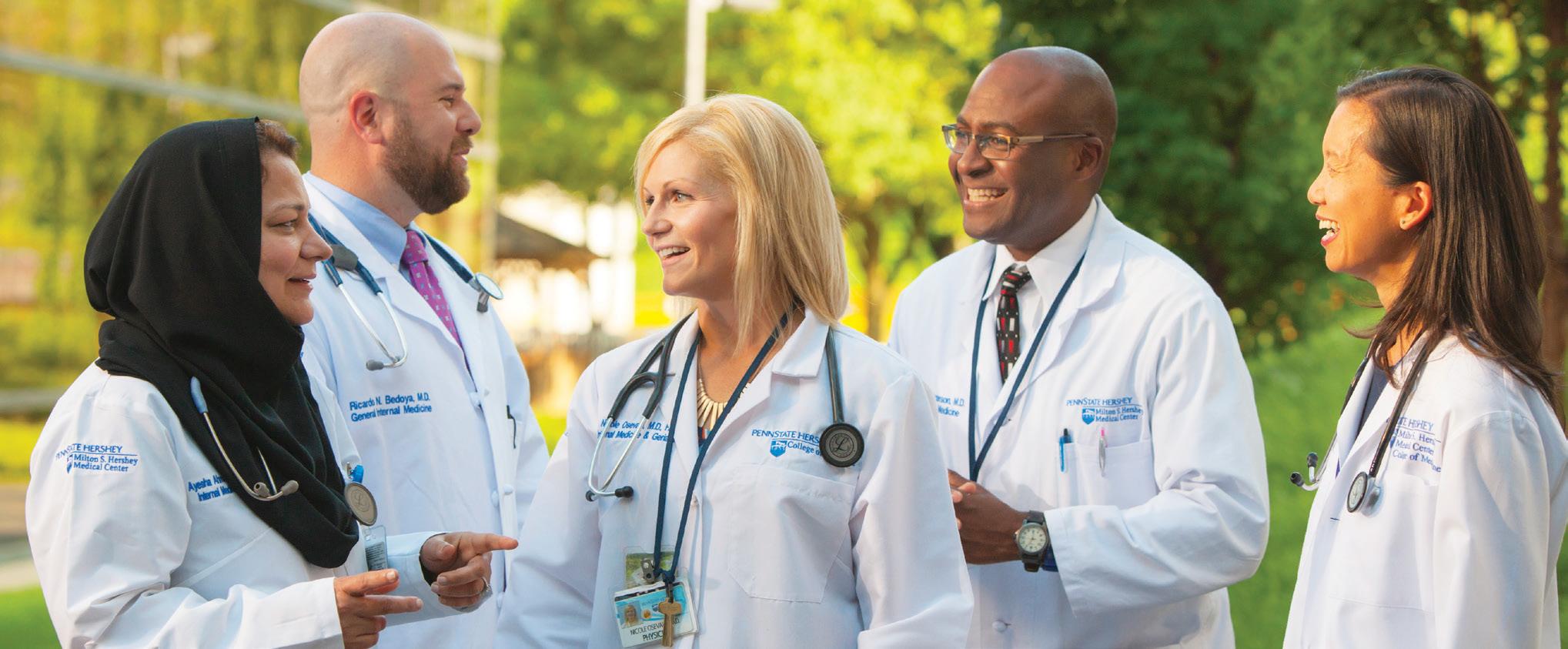
GENERAL NEUROLOGIST OPPORTUNITY
Neurologists with clinical expertise in General Neurology are invited to apply for an open position at Penn State Health Holy Spirit located in Camp Hill, PA. Join our growing community practice now! This search represents part of a major institutional commitment to expansion of the neurosciences. This position is supported by one other Neurologists, in a patent-focused community practice setting. With NO ON CALL and an 8 am to 5 pm schedule the selected candidate will fl ourish in a supportive work life balance environment. Leadership opportunities are available to those with relevant experience.
Ideal Candidates Will Have The Following:
• Medical degree - MD, DO, or foreign equivalent • Completion of an accredited residency program • Excellent patient care abilities and interest in teaching
As a member of the Department of Neurology you will be associated with:
• An outstanding program with a national reputation • A highly collaborative culture • Cutting-edge basic and clinical neuroscience research and top-notch facilities at both the Hershey and the University Park campuses • Interaction with dynamic clinicians across all neuroscience-related departments and participation in innovative educational approaches
Competitive compensation and generous benefi ts, including:
• Relocation Assistance • Penn State Tuition Discount • Medical, Dental, Vision • Back-up Family Care • 401K, 403(b), 457(b) retirement plans

Penn State Health is fundamentally committed to the diversity of our faculty and staff. We believe diversity is unapologetically expressing itself through every person’s perspectives and lived experiences. We are an equal opportunity and affi rmative action employer. All qualifi ed applicants will receive consideration for employment without regard to age, color, disability, gender identity or expression, marital status, national or ethnic origin, political affi liation, race, religion, sex (including pregnancy), sexual orientation, veteran status, and family medical or genetic information.

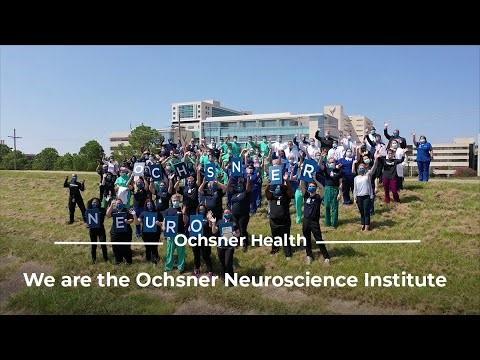
Now Recruiting BC/BE Neurologists Throughout Southern Louisiana
This is a great opportunity to practice neurology in a collegial and patient-focused environment. Academic appointments are available at our affiliated institutions, including Tulane, LSU, and the University of Queensland. Both newly trained and experienced physicians are encouraged to apply. We offer a highly competitive salary with comprehensive benefits.
We are looking for subspecialty training/ interest in the following areas: · HEADACHE · COGNITIVE DISORDERS · MOVEMENT DISORDERS · NEUROMUSCULAR · NEUROHOSPITALIST · STROKE/VASCULAR
Learn more at: ochsner.org/neurorecruitment
Please stop by our virtual booth to meet our physician recruiters!
Become a part of our legacy and help us build a healthier future!
Mercy Clinic is seeking BE/BC Neurologists – OUTPATIENT ONLY to join our established practices throughout our healthcare ministry
Our Positions offer:
• Large, fully integrated health system utilizing EPIC • Competitive compensation model with professional liability coverage (occurrence based) • Attractive schedules (great work/life balance) • CME allowance and $10,000 relocation assistance • Comprehensive benefits including health, dental, vision and life insurance (eligible first day) • Retirement options with employer matching • Not-for-profit organization, 501(c)(3), qualifies for Public
Service Loan Forgiveness program
Mercy, includes more than 40 acute care and specialty (heart, children’s, orthopedic and rehab) hospitals, 900 physician practices and outpatient facilities, 40,000-plus co-workers and 2,100 Mercy Clinic physicians in Arkansas, Kansas, Missouri and Oklahoma. Mercy also has clinics, outpatient services and outreach ministries in Arkansas, Louisiana, Mississippi and Texas.
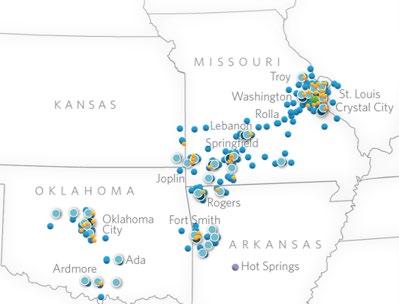
For more information, please contact our team:
Brandon Smith, Physician Recruiter (Oklahoma)
Office: (405) 752-3544 | Email: Brandon.Smith@mercy.net
Dayna Pangle, Senior Physician Recruiter (Southwest Missouri)
Office: (417) 820-6279| Email: Dayna.Pangle@mercy.net
Lisa Hauck, Senior Physician Recruiter (Northeast Missouri)
Office: (314) 364-2949| Email: Lisa.Hauck@mercy.net
Sarah Wilson, Senior Physician Recruiter (Fort Smith, Arkansas)
Office: (479) 314-7466 | Email: Sarah.Wilson2@mercy.net
Mark Rowe, Physician Recruiter (Northwest Arkansas) Office: (417) 556-5469 | Email: Mark.Rowe@mercy.net
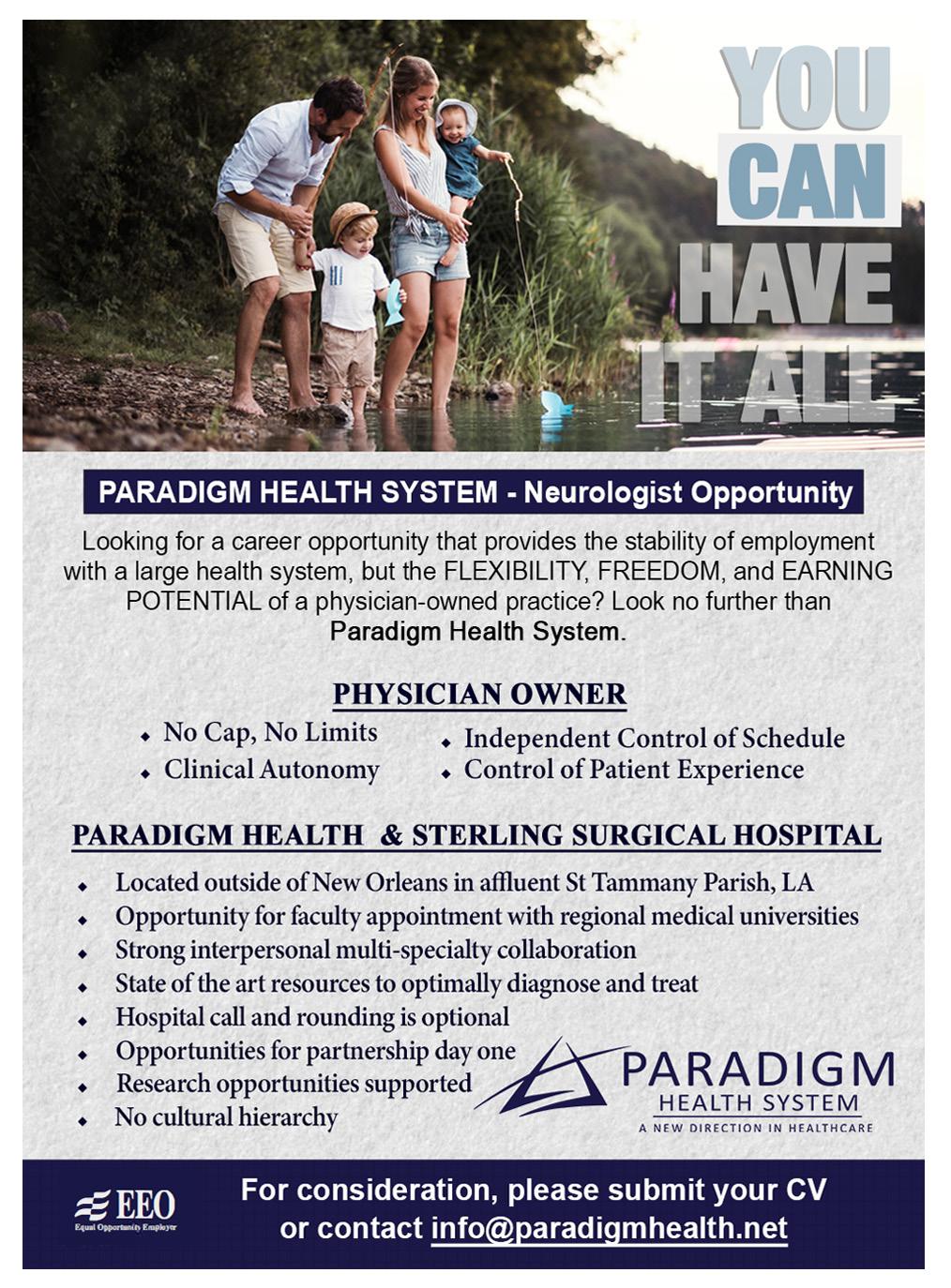
Top-talent Neurologists needed for award-winning healthcare system in Cincinnati, OH
TriHealth is seeking BE/BC Neurologists for positions that offer autonomy on a team that works collaboratively in the collective practice. Opportunities include: • Vascular Neurologist • Neurologist with interest/experience in Stroke,
Epilepsy, Movement Disorders, Neuromuscular/EMG You will provide phenomenal care to a large, diverse patient population from referrals provided by the well-established TriHealth physician community. Enjoy comprehensive benefits, excellent work/life balance, productivity incentives and sign-on bonus. Attractive relocation packages are available.
Call, text or send your CV to: melissa_jansing@trihealth.com 859 653 1392
TriHealth.com
TriHealth TriHealth TriHealth TriHealth TriHealth TriHealth
TriHealth TriHealth TriHealth TriHealth TriHealth TriHealth
The University of Toledo College of Medicine Department of Neurology is recruiting neurologists and subspecialists to join their expanding department in an exciting new educational affiliation with Promedica, a comprehensive health care network of specialized hospitals and outpatient facilities in Northwest Ohio and Southeast Michigan. Nationally recognized for excellence, the department has a 4-week required third year clerkship for medical students, a growing Neurology residency program and several competitive fellowship programs.
The flagship academic medical center is a 794-bed hospital offering brand new state of the art inpatient facilities and is the largest acute care facility in the area. It has been named on of Healthgrades’ 100 Best Hospitals in America. Outpatient services are offered in the newly built Neurosciences Center, conveniently located across from the Toledo Hospital.
Multiple faculty positions for clinicians and clinician scientists are available in a variety of Neurology subspecialties, with most having an established practice including:
NEUROMUSCULAR DISORDERS • HEADACHE MEDICINE • BEHAVIORAL NEUROLOGY MOVEMENT DISORDERS • PEDIATRIC NEUROLOGY • GENERAL NEUROLOGY
Candidates with interest in translational research and/or independent research funding are strongly encouraged to apply. Joint appointment in Department of Neurosciences and protected time for research will be available based on track record and interest.
Assistant or Associate Professor Rank commensurate with experience. Applicants should be board eligible or board certified in Neurology, with fellowship training preferred for specialty positions.
Please submit a letter of interest, CV, and references to:
Imran I. Ali, MD
Professor and Clair Martig Endowed Chair, Department of Neurology, University of Toledo 2130 W. Central Avenue, Suite 201, Toledo, OH 43606 or email Imran.ali@utoledo.edu or ann.murphy@utoledo.edu .
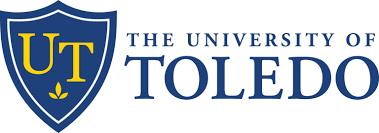

GENERAL NEUROLOGIST OPPORTUNITY
Penn State Health St. Joseph in Berks County, Pennsylvania is seeking a general neurologist to join our existing practice. The selected candidate will have both inpatient and outpatient responsibilities. This is an excellent opportunity for a neurologist who wishes to enjoy a high-quality of life while providing care within a community of approximately 400,000.
What We’re Seeking
• Medical degree – MD, DO • BC/BE in Neurology • Candidates with subspecialty training encouraged to apply
What We’re Offering:
• A competitive salary and generous benefits • Outstanding program and highly collaborative culture • Interaction with dynamic clinicians • Routinely ranked among the Top 50 Heart Hospitals in the country in quality metrics • Nationally certified as a Center of Excellence in Chest Pain, Stroke and Heart Failure • Nursing care that has also earned the distinction as a “Pathways to Excellence” accredited facility
FOR ADDITIONAL INFORMATION, PLEASE CONTACT:
Penn State Health is fundamentally committed to the diversity of our faculty and staff. We believe diversity is unapologetically expressing itself through every person’s perspectives and lived experiences. We are an equal opportunity and affirmative action employer. All qualified applicants will receive consideration for employment without regard to age, color, disability, gender identity or expression, marital status, national or ethnic origin, political affiliation, race, religion, sex (including pregnancy), sexual orientation, veteran status, and family medical or genetic information.



